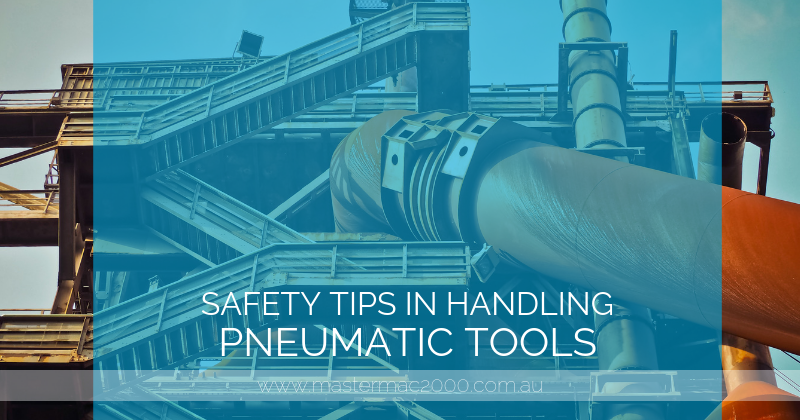Safety Tips in Handling Pneumatic Tools

Knowing how to safely operate a pneumatic tool, which is run on compressed air, is very critical. This is for the reason that compressed air can be dangerous, especially in tools such as drills, jackhammers, and pneumatic nailers. Extra caution should be observed as accidents involving pneumatic tools can occur if proper safety measures are not followed.
For everyone’s safety, here are tips to remember when handling pneumatic tools.
Check the manual
Before you begin operating your chosen tool, read the instruction manual completely. Regardless of the idea that you have previously operated a similar tool, it is still best to understand how it works, especially when the risk of injury and damaging the tool are concerned.
Use safety equipment
Always use safety glasses/goggles, gloves, and other safety equipment whenever it is appropriate. Before you allow others to use your tools, inspect if they are wearing the right safety gear. With this, accidents and possible liability suit are prevented from happening.
Caution of use
When using nailers and staplers, refrain from pointing them at another person to not cause any harm or injury. Make sure that others are safe while you are using the tools. Consider setting up safety screens to protect others from flying debris and dust.
Taking care of tools
Don’t let your tools get jammed or clogged. Clean and oil them regularly. Avoid using any attachments that are not compatible with the pneumatic tool you are currently using. Don’t force a tool to accept an attachment that is not intended for a specific use.
Remember not to use a tool at an air pressure that exceeds the maximum limit that was specified by the manufacturer. To not create hazards, do not place the air hose in areas that have rough objects such as in walkways. Also, when operating a pneumatic tool, don’t use the hose as a handle. And if you are done using the tool or switching to a different tool, always remember to shut the air off.
Procedures in operating air hoses
Avoid using mismatched hoses and fittings; instead, check the diameters carefully. Inspect damages in the hoses more often. If found that there’s a bad hose, replacing it with a new one is the best thing to do and should be done immediately. And before connecting the air hoses, hold the line away from you and blow it out. Keep in mind to only employ hoses that are made for pneumatic tools that are highly flexible and can withstand breaking.
If you want to learn more about such tools, keep updated on Mastermac2000.com.au.

About MasterMac2000: Your Trusted Pneumatic & Process Automation Partner.
LEADING THE INDUSTRY: Established in 1989, MasterMac2000 has grown to become one of Australia's largest privately owned pneumatic and process automation companies. We stock top-quality brands like Univer, Mack, Tolomatic, Mac, Piab, American, and Rotoflux in Brisbane.
SERVING QLD & NORTHERN NSW: We proudly service Queensland and Northern New South Wales for all your pneumatic and process equipment needs. Our mission is to provide the best pre and post-sales support while actively expanding our client base.
SOURCING HARD-TO-FIND PARTS: Not only do we stock quality components, but we also excel at sourcing those elusive, hard-to-find parts. With our extensive database and global network of contacts, getting the parts you require is as easy as a call to our highly skilled, professional sales team.
DEDICATED TO YOUR SUCCESS:
- Decades of expertise in pneumatics & process automation
- Carefully curated selection of world-class brands
- Exceptional sourcing capabilities for speciality parts
- Knowledgeable sales staff dedicated to finding solutions
- Unwavering commitment to customer service excellence
About The Author
Stuart Havill
Stuart Havill is the owner and manager of MasterMac2000, Queensland's largest privately owned pneumatic and process valve company.
With his early working career as a maintenance fitter for Boral in 1992, Stuart has spent his life in the field of pneumatics and process equipment. He gained extensive experience in plant design, maintenance, repairs, fabrication, and site management.
In 1996, he transitioned to a pneumatic sales technician role at MasterMac2000, where he excelled in key account management, providing cost-effective solutions, and managing a sales team of 9 employees.
Since 2002, Stuart has been the manager at MasterMac2000, overseeing the company's growth and establishing it as a leader in pneumatic automation and process valve engineering. His expertise spans customer training, CRM setup, industrial compressor sizing and installation, and turn-key project management.
Under Stuart's leadership, MasterMac2000 has been servicing the industry since 1988, with 5 full-time sales representatives covering northern rivers NSW, Queensland, Northern Territory, and PNG. The company prides itself on providing the best-priced solutions to all customers in the marketplace.
View Stuart’s LinkedIn profile to learn more about his expertise in pneumatics and process equipment.